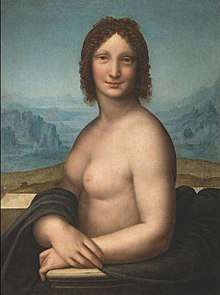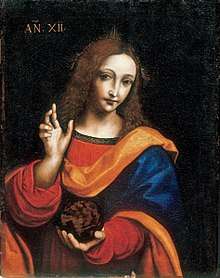Salaì
Gian Giacomo Caprotti da Oreno, better known as Salaì[1] (1480 – before 10 March 1524), was an Italian artist and pupil of Leonardo da Vinci from 1490 to 1518. Salaì entered Leonardo's household at the age of ten. He created paintings under the name of Andrea Salaì. He was described as one of Leonardo's students and lifelong servant and is thought by some to be the model for Leonardo's St. John the Baptist and Bacchus.
Salaì | |
|---|---|
Drawing thought to be Salaì by Leonardo da Vinci | |
| Born | Gian Giacomo Caprotti da Oreno 1480 Oreno, Vimercate, Italy |
| Died | 1524 (aged 43–44) Milan, Italy |
| Nationality | Italian |
Notable work | Monna Vanna |
| Movement | High Renaissance |
| Spouse(s) | Bianca Coldiroli d’Annono |
| Patron(s) | Leonardo da Vinci |
Early life

Salaì was born in 1480 as son of Pietro di Giovanni, a tenant of Leonardo's vineyard near the Porta Vercellina, Milan.[2]
He joined Leonardo's household at the age of ten as an assistant. Vasari describes Salaì as "a graceful and beautiful youth with curly hair, in which Leonardo greatly delighted".[2] Although Leonardo described him as "a liar, a thief, stubborn and a glutton" and he stole from Leonardo on at least five occasions, he kept him in his household for more than 25 years, in which he trained as an artist.[2] Salaì became a capable, although not very impressive, painter,[3] who created several works, including the Monna Vanna, a nude version of the Mona Lisa which may be based on a charcoal sketch by Leonardo.[4][5] He is also considered one potential creator of the Prado's copy of the Mona Lisa.[6]
Leonardo is thought to have used Salaì as the model for several of his works, specifically St. John the Baptist and Bacchus.[6] Some researchers also believe that Salaì and not Lisa del Giocondo was the real model for the Mona Lisa but this claim is disputed by the Louvre.[6]

During Leonardo's second stay in Milan, he took another young pupil, Francesco Melzi. Unlike Salaì, Francesco was a son of a nobleman. When Leonardo traveled to Rome in 1513 and to France in 1516, Salaì and Melzi both accompanied him. As an adult, Melzi became secretary and main assistant of Leonardo, and undertook to prepare Leonardo's writings for publication. Vasari says that Melzi "at the time of Leonardo was a very beautiful and very much loved young man". In France, Francesco Melzi was greeted as "Italian gentleman living with master Leonardo" and granted donation of 400 ecus, while Salaì, already over 40 years old, was described as "servant" and granted a one time donation of 100 ecus. Salaì left Leonardo and France in 1518. He later returned to Milan to work on Leonardo's vineyard, previously worked by Salaì's father, half of which was granted to him by Leonardo's will.[7] It is commonly believed that upon Leonardo's death in 1519, Salaì inherited several paintings including the Mona Lisa. Through his estate, many of those works, notably the Mona Lisa, passed into the possession of Francis I of France.[8] While Leonardo left all personal belongings, paintings, drawings and notes to Francesco Melzi in his will, it is unclear whether this included the Mona Lisa.[9]
Salaì married Bianca Coldirodi d'Annono on June 14, 1523, at the age of 43.[10] Salaì died in 1524 as a result of a wound received from a crossbow in a duel against the French troops and was buried in Milan on 10 March 1524.[11]
Salaì's sexuality

A number of drawings among the works of Leonardo and his pupils make reference to Salaì's sexuality. There is a drawing modelled on Leonardo's painting John the Baptist and called The Angel Incarnate, of a young man nude with an erect phallus, and appearing to represent Salaì. The face of the figure is closer to Salaì's copy of Leonardo's painting, than to the original John the Baptist in the Louvre. It may have been drawn by Salaì himself. A folio by Leonardo includes a page of drawings by a hand other than Leonardo's, one of which is a crudely drawn sketch depicting an anus, identified as "Salaì's bum", pursued by penises on legs.[2][note 1]
Relationship to the Mona Lisa
A group of Italian researchers has claimed that Salaì was the model for the Mona Lisa, noting the similarity in some of the facial features, particularly the nose and mouth, to those in which Salaì is thought to have been the model. These claims have been disputed by the Louvre. The letters which form "Mona Lisa" can be rearranged to form "Mon Salaì".[12]
In popular fiction
- Salaì is a principal character in the novel Cenacolo[13] by Joseph Orbi.
- In Paul McAuley's novel Pasquale's Angel set in an alternate Italian Renaissance, Salaì is the main antagonist.
- DC Comics' 1995 Vertigo series Chiaroscuro: The Private Lives of Leonardo da Vinci (later published as a graphic novel) tells a speculative story of a love affair between Leonardo and Salaì.
- In a DLC of the video game Assassin's Creed: Brotherhood, Ezio (protagonist) interacts with Salaì when searching for Leonardo da Vinci. The game portrays Salaì as Leonardo's lover, and that Ezio is aware of the relationship. He is supportive of it, telling Leonardo that he approves of his relationship.
- Giacomo is the main character in the novel Leonardo's Shadow by Christopher Grey[14]
- Salaì is the main character in the children's historical fiction novel The Second Mrs. Giaconda by E. L. Konigsburg.
- Salaì is a principal character with Leonardo in Mário Cláudio's 2014 Portuguese novel Retrato de Rapaz (Portrait of a Boy).
Notes
- The page on which this sketch appears is the same page that contains the depiction of a bicycle. Neither drawing is by Leonardo, and the page was not seen until a restoration of the volume in the 1960s, in the process of which, several pages went missing and were later returned. It has been suggested that the drawings are by a pupil of Leonardo's but this is debated.
References
- "Salaì" is a contracted form of Saladino, referred to Gian Giacomo by Leonardo da Vinci as a joke nickname – since he was a child – because he had a terrible temperament, dangerous as the Saladin, so as an infidel (because Saladin was non-Catholic), and therefore by extension as a demon, as a (little) devil.
- Stern, Keith (September 1, 2009). Queers in History: The Comprehensive Encyclopedia of Historical Gays, Lesbians and Bisexuals. BenBella Books. p. 276. ISBN 978-1-933771-87-8.
- Hall, M. C. (September 2007). Leonardo Da Vinci. ABDO Publishing Company. p. 53. ISBN 1-59928-844-3.
- "Expert: Da Vinci painted nude Mona Lisa". UPI News. 16 November 2009. Retrieved 22 March 2011.
- "'Mona Lisa nude sketch' found in France". BBC News. 2017-09-28. Retrieved 2017-09-29.
- Waters, Florence (2012-03-06). "Mona Lisa copy may have been painted by Leonardo da Vinci's lover, art historians suggest". The Telegraph. Retrieved 2017-09-29.
- Rui, Andrea (2016-03-07). Santa Maria delle Grazie (in Italian). Andrea Rui. p. 6. ISBN 9788892563704.
- Zöllner, Frank (May 1, 2000). Leonardo da Vinci, 1452–1519. Taschen. p. 94. ISBN 3-8228-5979-6.
- Capra, Fritjof (2007-10-30). The Science of Leonardo: Inside the Mind of the Great Genius of the Renaissance. Knopf Doubleday Publishing Group. p. 13. ISBN 9780385524117.
- Claire J. Farago, Taylor and Francis Inc, Leonardo's Art – Twentieth-Century Connoisseurship and Iconographic Studies, Leonardo's Projects from 1500–1519, Vol 3 (1999) p 397
- da Vinci, Leonardo (1999). Farago, Claire J. (ed.). Leonardo Da Vinci, Selected Scholarship: Leonardo's projects, c. 1500-1519. Taylor & Francis. p. 397. ISBN 9780815329350.
- "Mona Lisa model was male, researchers say". ABC News. February 3, 2011. Retrieved 22 March 2011.
- Orbi, Joseph (2010-05-12). "Cenacolo: Novel". I.O. Twomey. ISBN 9780966161984. Retrieved 2013-07-24.
- Leonardo's Shadow. 2008-03-04. ISBN 9781416905448.
External links
| Wikimedia Commons has media related to Gian Giacomo Caprotti. |
- Leonardo da Vinci: anatomical drawings from the Royal Library, Windsor Castle, exhibition catalog fully online as PDF from The Metropolitan Museum of Art, which contains material on Salaì (see index)
- The L(eonardo) and the S(alai)